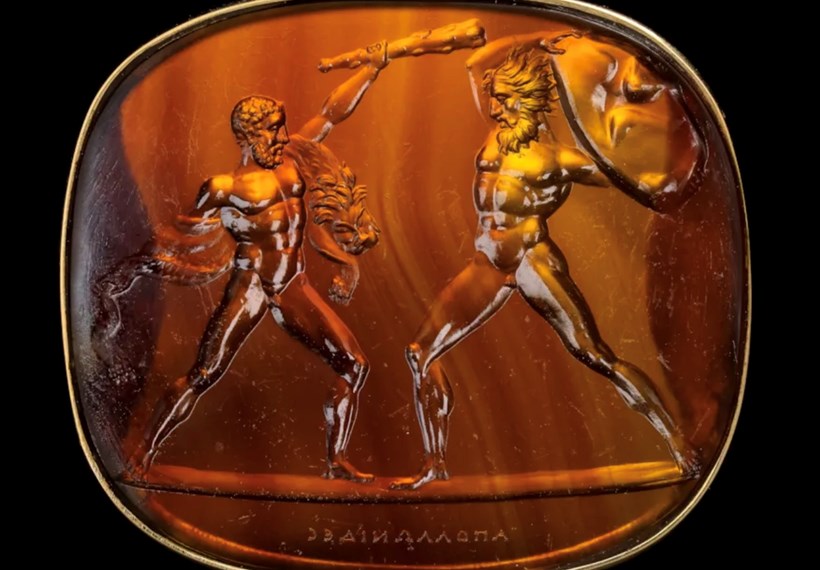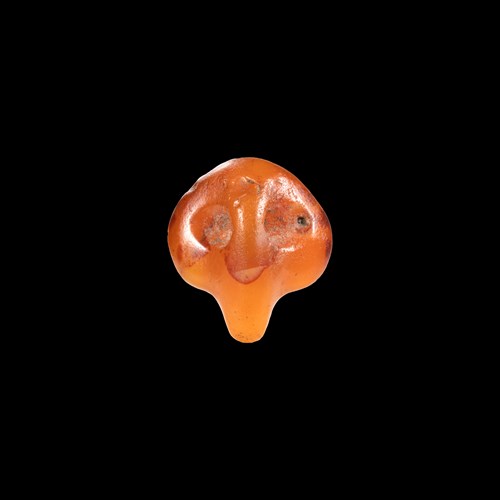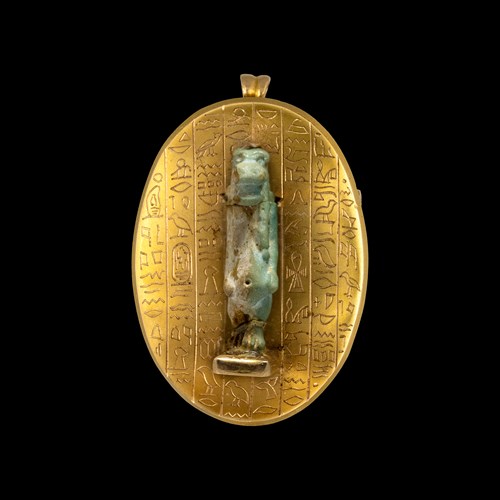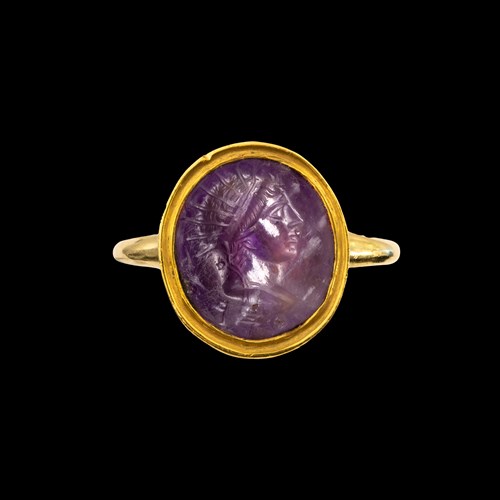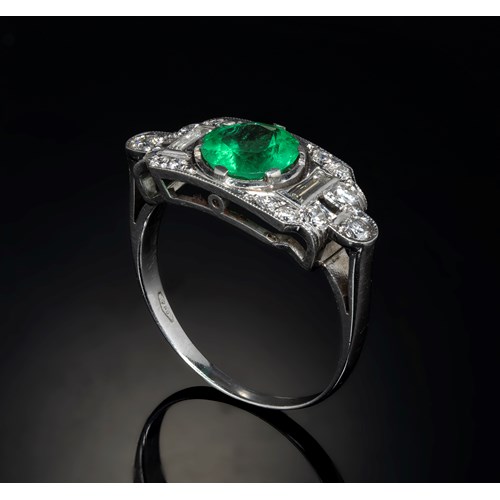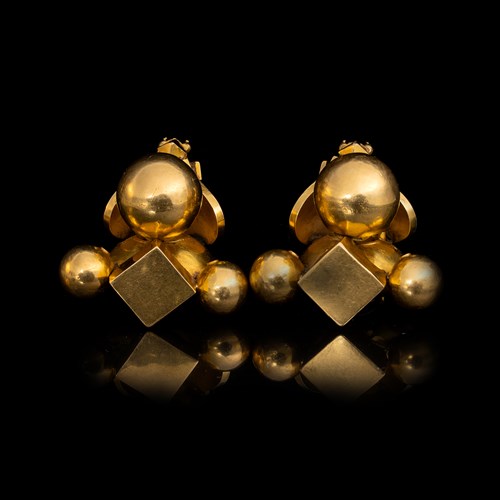Marketplace
G. CERBARA (1770-1856). An agate cameo set in a 19th century articulated gold bracelet. Psyche.
GIUSEPPE CERBARA
G. CERBARA (1770-1856). An agate cameo set in a 19th century articulated gold bracelet. Psyche.
Date circa 1820
Period 19th century
Origin London, consignment
Medium Agate, gold
Dimension 18 cm (7¹/₈ inches)
This stunning gold articulated bracelet is decorated with chiseled floral pattern, with in the center, a large oval box-setting with a three-layered agate cameo by Giuseppe Cerbara (ROMA 1770 - ROMA 1856).
Bust of Psyche facing left. The diaphanous nature of Psyche's butterfly wings is indicated by a delicate use of the third brownish layer of the stone with small circular cuts. Her profile is characterized with esquisite features, the gaze downward. Her bust is partially covered by a tunic also engraved in the the brownish layer and hold by a fibula. In the right field, signed CERBARA.
Mounting in beautiful condition, slightly toned.
Daughter of a king, beautiful to the point of frightening potential suitors, Psyche, whose name in Greek means soul, had aroused the jealousy of Aphrodite. The goddess therefore instructs her son Eros (Cupid) to make her fall in love with a monster and, through the intermediary of a soothsayer, she orders Psyche's parents to expose her on a rock. But Eros, himself seduced, fails in his mission: by means of a zephyr, he kidnaps the young mortal from his palace. There she will be able to enjoy all her riches as well as the pleasures of love, on the condition that she will not seek to see the one who now shares her bed. On the bad advice of her jealous sisters who came to visit her, Psyche does not take long to shatter her happiness: equipped with a lamp that she had hidden, she leans over her sleeping lover. But, moved to discover him so handsome, she drops a drop of burning oil on him. Suddenly awakened, he disappears into the air, calling his name. So begins a frantic quest for Psyche around the world. Hunted from all sides, she ends up in the home of Aphrodite who holds her as a slave and overwhelms her with a thousand torments and a thousand labors before sending her to the underworld to ask Persephone for a precious bottle. On the way back, Psyche uncorks it and falls into a deep sleep. But Eros, who had not been able to forget her, awakens her with a sting of his arrows and, going back to Olympus, obtains permission from Zeus to marry her. This is how Psyche became immortal and Aphrodite, reconciled, became the grandmother of Volupté. A love story that ends well, and a myth that has often been used by artists, whether in painting, sculpture or even tapestry. Subject to numerous interpretations, the myth allows us to evoke subjects such as true love, marriage, the separation of lovers and the trials to overcome to find the loved one. It also allows artists to create works imbued with great sensuality and a certain eroticism.
Bust of Psyche facing left. The diaphanous nature of Psyche's butterfly wings is indicated by a delicate use of the third brownish layer of the stone with small circular cuts. Her profile is characterized with esquisite features, the gaze downward. Her bust is partially covered by a tunic also engraved in the the brownish layer and hold by a fibula. In the right field, signed CERBARA.
Mounting in beautiful condition, slightly toned.
Daughter of a king, beautiful to the point of frightening potential suitors, Psyche, whose name in Greek means soul, had aroused the jealousy of Aphrodite. The goddess therefore instructs her son Eros (Cupid) to make her fall in love with a monster and, through the intermediary of a soothsayer, she orders Psyche's parents to expose her on a rock. But Eros, himself seduced, fails in his mission: by means of a zephyr, he kidnaps the young mortal from his palace. There she will be able to enjoy all her riches as well as the pleasures of love, on the condition that she will not seek to see the one who now shares her bed. On the bad advice of her jealous sisters who came to visit her, Psyche does not take long to shatter her happiness: equipped with a lamp that she had hidden, she leans over her sleeping lover. But, moved to discover him so handsome, she drops a drop of burning oil on him. Suddenly awakened, he disappears into the air, calling his name. So begins a frantic quest for Psyche around the world. Hunted from all sides, she ends up in the home of Aphrodite who holds her as a slave and overwhelms her with a thousand torments and a thousand labors before sending her to the underworld to ask Persephone for a precious bottle. On the way back, Psyche uncorks it and falls into a deep sleep. But Eros, who had not been able to forget her, awakens her with a sting of his arrows and, going back to Olympus, obtains permission from Zeus to marry her. This is how Psyche became immortal and Aphrodite, reconciled, became the grandmother of Volupté. A love story that ends well, and a myth that has often been used by artists, whether in painting, sculpture or even tapestry. Subject to numerous interpretations, the myth allows us to evoke subjects such as true love, marriage, the separation of lovers and the trials to overcome to find the loved one. It also allows artists to create works imbued with great sensuality and a certain eroticism.
Date: circa 1820
Period: 19th century
Origin: London, consignment
Medium: Agate, gold
Signature: CERBARA (field right)
Dimension: 18 cm (7¹/₈ inches)
More artworks from the Gallery


. An agate cameo set in a 19th century articulated gold bracelet. Psyche_T638816789898352365.jpg?width=2000&height=2000&mode=max&scale=both&qlt=90)
